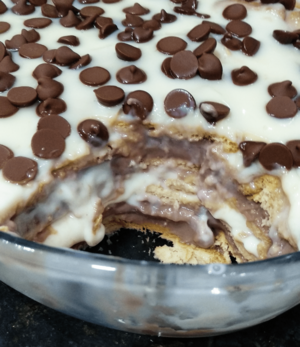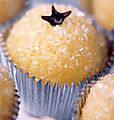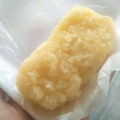List of Brazilian sweets and desserts facts for kids
Brazil is a huge country with many different cultures! Its food, called Brazilian cuisine, is a mix of ideas from Europe, Africa, and the native people of the Americas. This means Brazilian sweets and desserts are super diverse and delicious, with each region having its own special treats.
Contents
Tasty Brazilian Sweets and Desserts
A–E: Sweet Treats from A to E
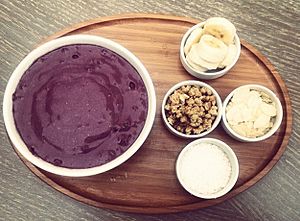
A bowl of açaí na tigela with yummy toppings.
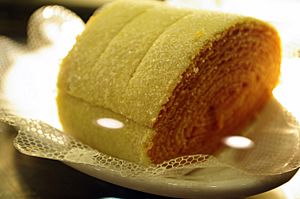
A beautiful Bolo de rolo cake.
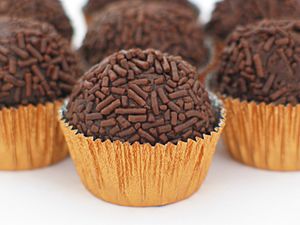
A classic Brigadeiro sweet.
- Açaí na tigela – This is a super popular Brazilian dish made from frozen and mashed açaí palm fruit. It's often served in a bowl like a smoothie, topped with fruits, granola, or honey. It's a refreshing and healthy treat!
- Amanteigado – These are buttery cookies or biscuits. They are simple, melt-in-your-mouth treats, perfect with a cup of coffee or milk.
- Beijinho – Meaning "little kiss," this is a common Brazilian candy, especially popular at birthday parties. It's made from condensed milk, coconut, and butter, often topped with a clove.
- Bolo de rolo – This special cake comes from the state of Pernambuco. It's made with thin layers of sponge cake rolled up with a sweet guava filling. It's so famous that it's even recognized as a national dish!
- Bom-bocado – This tasty coconut torte is often enjoyed during Brazil's Independence Day celebrations. It's a sweet and moist cake that many people love.
- Brigadeiro – This is perhaps the most famous Brazilian sweet! It's a traditional chocolate fudge ball, usually made with condensed milk, cocoa powder, and butter, then covered in chocolate sprinkles. You'll find them at almost every Brazilian party.
- Cajuzinho – Meaning "little cashew," this sweet is made from peanuts, cashew nuts, and sugar. It's shaped like a tiny cashew nut and is a popular party candy, just like brigadeiros.
- Canjica – This is a popular sweet dish, especially during the June Festivals (Festa Junina). It's made with canjica corn, cooked until soft, and often served with milk, sugar, and cinnamon.
- Cocada – A traditional coconut candy found all over Latin America. It comes in different colors and textures, from soft and chewy to hard and crunchy.
- Cocada branca – White cocada.
- Cocada morena – Brown cocada.
- Cocada preta – Dark cocada.
- Creme de papaya – A simple and delicious frozen dessert made with papaya fruit and often served with a splash of cassis liqueur. It's a light and refreshing end to a meal.
- Curau – This is a sweet, custard-like dessert. It's made from the juice of unripe corn, cooked with milk and sugar until it becomes thick and creamy. It's often sprinkled with cinnamon.
F–J: From Fios to Jaca
- Fios de ovos – These are traditional Portuguese sweets made from egg yolks. The yolks are drizzled into hot sugar syrup, creating thin, noodle-like strands. They are used in many Brazilian desserts and sometimes as a side dish.
K–O: Treats from K to O
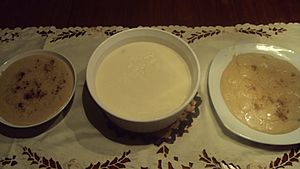
A bowl of Manjar blanco, a creamy milk-based dessert.
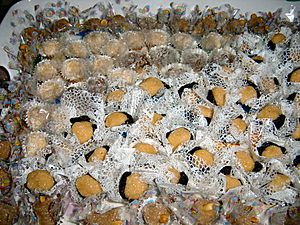
A close-up of an Olho-de-sogra sweet.
- Manjar blanco – This is a term used in Spanish-speaking countries for various milk-based desserts. In Brazil, it often refers to a pure white coconut pudding.
- Maria-mole – Similar to a marshmallow, Maria-mole is a soft, airy sweet. Its main ingredients are sugar, gelatin, and egg whites, and it's usually covered in grated coconut.
- Mugunzá – This is a porridge made with white corn kernels, cooked with milk, sugar, and cinnamon until it's tender and creamy. It's a comforting and hearty sweet dish.
- Olho-de-sogra – This fun candy means "mother-in-law's eye" in Portuguese! It's a Brazilian sweet made with a dried plum wrapped in a sweet coconut mixture, often resembling an eye.
P–T: Delicious Desserts from P to T
- Paçoca – A popular candy made from ground peanuts, sugar, and a pinch of salt. It has a crumbly texture and a rich peanut flavor.
- Pão de mel – Meaning "honey bread," this is a small, soft cake made with honey. It's often filled with condensed milk cream and covered with a thin layer of chocolate.
- Papo-de-anjo – This traditional Portuguese dessert means "angel's double chin." It's made from whipped egg yolks, baked, and then boiled in sugar syrup, making them very soft and sweet.
- Pavê – This dessert is similar to the Italian Tiramisu. It's made by layering biscuits (like ladyfingers or Marie biscuits) with creamy chocolate and condensed milk. It's a popular no-bake dessert.
- Pé-de-moleque – This candy is made with peanuts and jaggery (a type of unrefined sugar) or molasses. It's crunchy and sweet, a favorite at Brazilian festivals.
- Queijadinha – This sweet treat originated in Portugal and is very common in Brazil. It's a small, baked tart or pastry made with cheese, coconut, condensed milk, and egg yolks.
- Quindim – A very popular Brazilian baked custard dessert. It's bright yellow and shiny, made with egg yolks, sugar, and ground coconut. It's often baked in small, individual molds.
- Rapadura – This is unrefined whole cane sugar, often sold in solid blocks. It's a natural sweetener used in many traditional Brazilian sweets.
- Sweet rice – Just like rice pudding you might know, this is a creamy dessert made from rice cooked with milk and sugar, often flavored with cinnamon.
- Sagu – A unique dessert from southern Brazil, especially the state of Rio Grande do Sul. It's made with tapioca pearls, sugar, and red wine, giving it a beautiful color and fruity taste.
Images for kids
-
Commercially prepared pé-de-moleque
See also

All content from Kiddle encyclopedia articles (including the article images and facts) can be freely used under Attribution-ShareAlike license, unless stated otherwise. Cite this article:
List of Brazilian sweets and desserts Facts for Kids. Kiddle Encyclopedia.

